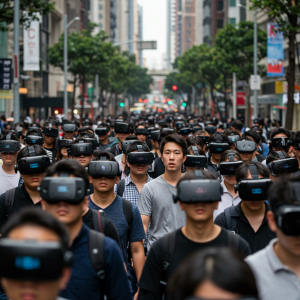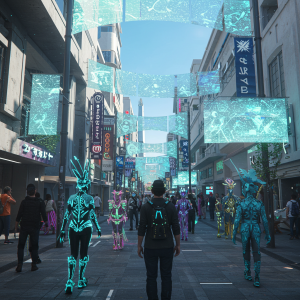The Prompt:
Describe or narrate a scenario about a brochure found two generations into a future in which order is deliberately coordinated or imposed. Your description should address issues related to inequality and elicit feelings of alienation.
The Story:
A man walks down a city street picking up garbage. He wears a set of dirty overalls and work boots. The street is incredibly plain, with no signs on the shop fronts or advertisements. All the other pedestrians wear simple jumpsuits without any decoration.

Everyone is wearing a set of augmented reality (AR) goggles or glasses. Everyone except for the garbage collector.

For everyone else, the view through the AR goggles projects a vibrant world of images, video, sounds, and symbols. Through these goggles, shops project menus and billboards display personalized ads tailored to the preferences of the individual. These multimodal communications are projected directly into the AR goggles and accompanying earphones, providing a multisensory virtual experience. Rather than expressing identity through clothing, the people project a customized virtual avatar that can be seen by others. These avatars are a hyper-customizable expression of identity that the people on the street project for others to see.

It wasn’t always like this. A couple generations ago, AR technology began as a novelty, but as the technology improved and became more widespread, virtual communications began to replace the physical ads, signs, and fashions that once permeated society.
As adoption increased, AR goggles and glasses soon became universal, much like smartphones. Market forces encouraged the exclusive use of AR representations which could be cheaply and easily created and modified through algorithmic processes.
However, during this transition, some people were left behind. Due to genetic conditions or disability, some people could not use the AR goggles effectively. Since most jobs, social events, and even education were mediated through this AR technology, these people were pushed into an underclass of workers, unable to participate in mainstream society. Supported by social assistance, they worked menial jobs like sanitation. Just like the man collecting garbage.
The man continued down the street, avoiding people immersed in and captivated by the virtual world projected onto their senses. He came upon a discarded brochure – a real paper brochure. Picking it up, he saw what looked like activist imagery. Early in society’s transition to AR, there were social movements to preserve the old way of communicating through physical media. However, those movements soon died out as books were digitized, art was converted to holograms, and AR technology rapidly replaced all previous forms of communication.

The man tossed the brochure into his trash bag. He was illiterate – the words on the page meaningless symbols. As a member of the underclass, he was never taught to read, and in fact written text has been steadily disappearing even in the virtual realm. Since non-linguistic modes of design have become so easy to create through algorithmic processes and sophisticated tools, symbolic communication that doesn’t rely on writing has proliferated. As society retreats further and further into virtual space, almost all communication is mediated through hyper-modal design that blends spatial, visual, audio, and gestural modes in a symbolic language of expression. The communication divide between the two groups grows as AR society interacts in increasingly sophisticated ways and the underclass is left further and further behind.
Without access to AR technology, the underclass become more and more alienated from the rest of mainstream society. The man continues on, collecting bits of trash in a sea of people that go about their lives, digital devices strapped to their heads.
All images were created with Google Gemini 2.0 Flash